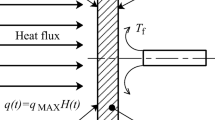Abstract
A new technique for determining the transient heat transfer coefficients from transient, measured temperatures inside solids is presented. The procedure is capable of handling complex geometries and the temperature dependence of the material properties. The method is straightforward and offers a great deal of flexibility in the model and the number of the unknown heat transfer coefficients. Numerical examples are presented as verification of the method.
Zusammenfassung
Es wird ein neues Verfahren zur experimentellen Bestimmung der lokalen instationären Wärmeübergangskoeffizienten entwickelt, wobei aus den Zeitverläufen der Fluidtemperatur und der an mehreren Stellen im Körper gemessenen Temperaturen ausgegangen wird. Das Lösungsverfahren eignet sich für Körper mit geometrisch komplizierten Formen und mit temperaturabhängigen Stoffwerten. Die Methode ist einfach und bietet eine hohe Flexibilität in bezug auf das Modell und die Anzahl der unbekannten Wärmeübergangskoeffizienten. Zum Verifizieren des Verfahrens werden verschiedene numerische Beispiele herangezogen.
Similar content being viewed by others
Abbreviations
- a :
-
inner surface radius of hollow cylinder or nozzle
- b :
-
outer surface radius of hollow cylinder or nozzle
- c :
-
specific heat
- f :
-
experimental data (measured temperature)
- h :
-
heat transfer coefficient
- H :
-
number of time steps in analysis interval
- k :
-
thermal conductivity
- L :
-
thickness of vessel
- M :
-
number of time intervals
- n :
-
unit outward normal to boundary surface
- N :
-
number of segments, also the number of grid points
- q :
-
rate of power generation per unit-volume
- r :
-
radial coordinate
- r :
-
space variable vector
- R :
-
relative radius defined as actual radius divided by outside radius
- S :
-
boundary
- t :
-
time variable
- T :
-
temperature
- V :
-
region
- z :
-
axial coordinate
- α :
-
thermal diffusivity
- Δh :
-
convergence tolerance, Eq. (6)
- Δr :
-
space increment inr direction
- ΔR :
-
dimensionless space increment inr direction
- Δt :
-
time step
- Δt k :
-
time interval, at which heat transfer coefficients are evaluated
- Δz :
-
space increment in z direction
- ɛ :
-
convergence tolerance, Eq. (4)
- ϱ:
-
density
- ▽:
-
gradient operator
- a :
-
inner
- b :
-
outer
- e, n, s, w :
-
boundary of control volume, Fig. 5
- E, N, S, W :
-
node identifier, Fig. 5
- i :
-
index of segments or grid points
- j :
-
index of thermocouple locations
- k :
-
index of time intervals
- N :
-
nozzle
- 0:
-
at time zero
- V :
-
vessel
- ∞:
-
ambient
- (l) :
-
number of iteration cycle
References
Davidson, M. J.; Jones, T. J.; Rosard, D. D.; Scheibel, J. R.: Monitoring for life extension. Transactions of the ASME. J. Pressure Vessel Technology 107 (1985) 255–259
Reason, J.: Measure how fast you're expending boiler life. Power 129 (1985) 31–34
Imber, M.: Temperature extrapolation mechanism for twodimensional heat flow. AIAA J. 12 (1974) 1089–1093
Imber, M.: Two-dimensional inverse conduction problem — further observations. AIAA J. 13 (1975) 114–115
Al-Najem, N. M.; Özisik, M. N.: On the solution of threedimensional inverse heat conduction in finite media. Int. J. Heat Mass Transfer 28 (1985) 2121–2128
Taler, J.: Ein numerisches Verfahren zur experimentellen Ermittlung des Wärmeübergangskoeffizienten in zylindrischen Bauteilen. Wärme-Stoffübertrag. 20 (1986) 229–235
Taler, J.: Erfassung instationärer Wärmebeanspruchung dickwandiger Kraftwerkskomponenten durch Wandtemperaturmessung. Brennstoff-Wärme-Kraft 39 (1987) 30–36
Taler, J.: Überwachung der instationären Wärmebeanspruchung in dickwandigen Bauteilen von Kraftwerksblöcken. Brennstoff-Wärme-Kraft 39 (1987) 484–489
Kreith, F.; Black, Z.: Basic heat transfer. New York: Harper and Row 1983
Taler, J.: Untersuchungen zur Verbesserung des dynamischen Verhaltens von Naturumlauf-Dampferzeugerfr. Fortschritt-Bericht der VDI-Zeitschriften, Reihe 6: Energieerzeugung. Düsseldorf: VDI 1986
Author information
Authors and Affiliations
Rights and permissions
About this article
Cite this article
Taler, J. A general method for the experimental determination of local transient heat transfer coefficients. Wärme- und Stoffübertragung 23, 283–289 (1988). https://doi.org/10.1007/BF01001054
Received:
Issue Date:
DOI: https://doi.org/10.1007/BF01001054




